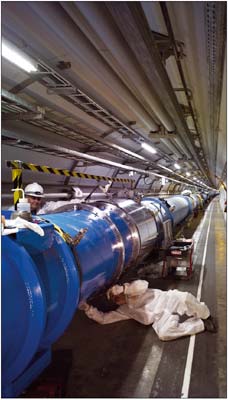
The LHC will initially run at an energy of 3.5 TeV per beam when it starts up in November this year. This decision has comes after all tests on the machine’s high-current electrical connections were completed at the end of July, indicating that no further repairs are necessary for safe running.
“We’ve selected 3.5 TeV to start,” explained CERN’s director-general, Rolf Heuer, “because it allows the LHC operators to gain experience of running the machine safely while opening up a new discovery region for the experiments. The LHC is much better understood than it was a year ago. We can look forward with confidence and excitement to a good run through the winter and into next year.”
Following the incident of 19 September 2008 that brought the LHC to a standstill, testing has focused on the 10,000 high-current superconducting electrical connections of the kind that led to the fault. These consist of two parts: the superconductor itself, and a copper stabilizer that carries the current in case of a quench – when the superconductor warms up and stops superconducting. There is negligible electrical resistance across these connections when they are in their normal superconducting state, but in a small number of cases tests have revealed abnormally high resistances in the superconductor. These have been repaired. However, there remain a number of cases where the resistance in the copper stabilizer connections is higher than it should be for running at full energy.
The latest round of tests has looked at the resistance of the copper stabilizer. As a result, many copper connections showing anomalously high resistance were repaired. The tests on the final two sectors, which concluded at the end of July, revealed no further anomalies. This means that no more repairs are necessary for safe running this year and next.
The procedure for the 2009 start-up will be to inject and capture beams in each direction, take collision data for a few shifts at the injection energy, and then commission the ramp to higher energy. The first high-energy data should be collected a few weeks after the first beam of 2009 is injected. The LHC will run at 3.5 TeV per beam until a significant data sample has been collected and the operations team has gained experience in running the machine. Thereafter, with the benefit of that experience, the energy will be taken towards 5 TeV per beam. At the end of 2010, the LHC will be run with lead ions for the first time. After that, the LHC will shut down and work will begin on moving the machine towards 7 TeV per beam.
Earlier in July leaks of helium into the vacuum insulation were found in Sectors 8-1 and 2-3 while they were being prepared for the electrical tests on the copper stabilizers at around 80 K. In both cases the leak occurred at one end of the sector, where the electrical feedbox, DFBA, joins Q7, the final magnet in the sector. The end vacuum subsectors – a 200 m stretch of the LHC sealed off by vacuum barriers – will be warmed to room temperature in order to locate the leaks and repair them. Suspicion rests in both cases on flexible hose in the liquid-helium transport circuits; two years ago, a similar leak occurred during the first cool-down of Sector 4-5. Unfortunately, the repair necessitates a partial warm-up of both sectors, with a consequent impact on the schedule for the restart. It is now foreseen that the LHC will be closed and ready for beam injection by mid-November.
• CERN is publishing regular updates on the LHC in its internal Bulletin, available at www.cern.ch/bulletin, as well as via Twitter and YouTube at www.twitter.com/cern and www.youtube.com/cern.





